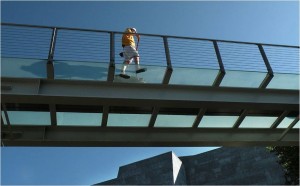I balanced precariously on the edge of the pavement trying not to be paralyzed with fear. After all, if my seven-year-old daughter could do it, surely I could. My wife could do it without a problem and even my three-year-old wanted to give it a try. So why was I afraid? After all, it’s just a bridge. All day long people walk back and forth over it without difficulty. For me, however, it was not quite so easy.
We were visiting Chattanooga, Tennessee, where we had lived for several years. Since we had moved away, someone had come up with the ridiculous idea of building a glass bridge spanning a highway along the Tennessee River. For some people, it’s really cool. Being able to take a leisurely stroll on an invisible bridge over a busy highway may seem like an interesting novelty. That is, unless you have acrophobia.
Acrophobia is better known as the fear of heights. Psychologists have come up with many theories about how we develop our phobias, but none of that mattered to me as I teetered on the brink of destruction. I loathe high places, especially transparent ones.
There I was, contemplating an attempt at what seemed to be the biggest and most daring step of my life. Neil Armstrong, while taking his “small step” on the moon, seemed like an amateur compared to this. At least he couldn’t see through the moon.
Somehow I managed to take a few treacherous steps, if for no other reason than to exhibit my manliness to my wife. It didn’t work. Standing in the middle of the bridge without a lick of fear and that delighted look in her eyes, she beckoned me to continue. No matter how much I desired to prove my masculinity and courage, I just couldn’t do it. I turned and slowly inched my way back to safety.
I had no doubt that the bridge was capable of holding me. However, although the bridge could support me, it didn’t. Why? Because I refused to let it. I had faith that it could hold me, but not the faith to allow it to hold me.
“Faith” is commonly misunderstood. We often use the word to refer to a person’s preferred religious system that might include church attendance, prayers, Bible reading, or a host of other things. It may also include knowledge of God and Jesus Christ. The truth is that this is not really faith at all. It is religion.
Faith can be defined as resting our full weight on something, knowing that if it fails, we will plummet to our death. In the Bible, the word “faith” is also translated as “believe.” Consider Jesus’ words that “whosoever believeth in Him should not perish, but have everlasting life” (John 3:16). Just to know about Jesus and to do religious acts is not enough.
As I stood on the bridge that day, I had an important decision to make. I could rest in the fact that I knew the bridge was strong enough to hold me. I could describe the structure of the bridge to anyone who would listen. I could set up a booth selling souvenirs to tourists and I could sing the praises of such a marvelous piece of infrastructure. However, until I become willing to set aside my fears and step out onto the bridge, I do not truly believe in it.
In the same way, all my knowledge and religious works result in falling “short of the glory of God” (Romans 3:23). Therefore, I have decided to trust in the power of Jesus Christ to allow me to approach God.
Let me encourage you to take that first step. It may be frightening, but until you rest solely in the death and resurrection of Jesus Christ, you will never experience the true forgiveness of God.
This article was published in my “Connections: Relating the Bible to Life” column in the Bremen Enquirer on Thursday, June 18, 2013.




